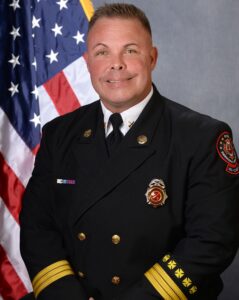The Crew That Stays Together Wins Together
April 20, 2025The Crew That Stays Together Wins Together
Offensive operations require company officers to stay with their crews, where their experience & knowledge have the biggest effect on incident outcomes & safety.
By Steve Lester
B Shifter Buckslip, April 22, 2025
You’re the captain of Truck 47, and you place your gear on the apparatus and take note of your assigned crew for the shift. Your driver/engineer is newly promoted and has been with your ladder company for three weeks. He has four years on the job, previously serving as a firefighter in a slower double company (engine/ladder) in the sixth battalion. Your back-step firefighters include a probationary firefighter who graduated from the academy two months ago and another firefighter working overtime to fill a vacancy for someone on extended sick leave. You’ve never worked a shift with him, but you know he has two years on the job. You make it through most of the shift, but at 0200 hours, you’re dispatched as first due to a residential structure fire. You arrive just ahead of the engine and park your apparatus on the Alpha side of the address. You key up the mic and deliver the most beautiful initial radio report of your career:
“Truck 47 is on the scene of a single-story residence. We have working fire from a single-story residence with heavy fire from the Alpha side. There is obvious attic extension with heavy smoke from the eaves. Engine 47 will be stretching a line to the Alpha side, performing a quick hit, and then proceeding interior for fire control. Truck 47 will be out doing a 360. We will be in the offensive strategy. Balance the alarm. Truck 47 will have Elm Street Command.”

You exit the apparatus and perform your 360 of the structure. You note the fire has extended from the front carport area to the Charlie side. You can differentiate the bedroom windows and note there is searchable space from two windows on the Charlie side. You verbally order your truck crew to the Charlie side with ground ladders to perform VEIS (vent, enter, isolate, search). At this point, multiple other resources begin to arrive on scene, and you have three engines already in Level 1 staging awaiting an assignment. Considering your resources and the task at hand, you decide to get back in the cab of the apparatus to command the incident from a strategic position. You transmit a follow-up report:
“Command to Radio with a follow-up report (dispatch acknowledges). 360 is complete. We have a walk-out basement on the Charlie side; no changes to the IAP. Truck 47 will be performing VEIS on the Charlie side. Truck 47’s officer will assume stationary command in Truck 47’s cab. Remaining in the offensive strategy. Accountability location is at Engine 47 on the Alpha side.”
After the follow-up report, you immediately assign an engine to establish a permanent water supply and another to go on deck on the Alpha side. Approximately 2 minutes after making these assignments, you receive a mayday call:
“Mayday, mayday, mayday. Truck 47 crew. The bedroom on the Charlie side flashed over, forcing us to bail out the Charlie side window. We have a PAR and are all outside on the Charlie side. I have one firefighter with an arm injury. We need an additional line to the Charlie side and EMS to treat our firefighter.”
In the hot wash and after-action reviews following this mayday event, you learned your crew had significant fire conditions on the Charlie side and fire impinging on the bedroom where VEIS was performed. Pre-flashover conditions were immediately present when they took the window for entry. Your crew failed to recognize this and entered the bedroom. The bedroom door had burned away, making it impossible to isolate the room. Flashover occurred.

So where, exactly, does the Swiss cheese line up for this incident? Let’s go back to the crew. The three crewmembers with the VEIS assignment have just over five years of combined experience. In today’s fire service, even the driver with four years of experience has likely been to fewer than 20 fires. We train our firefighters to be knowledgeable and competent on the fireground. But the fact is that firefighters are task-level performers. Their job is to receive an assignment and complete that task. Chances are, the crew was focused on the task and never took a second to consider the fire conditions as a critical fireground factor. They also didn’t consider that the bedroom door had burned away, indicating the fire was heading in their direction. The company officer is responsible for standing back, monitoring conditions, considering critical factors and altering task-level decisions based on current conditions.
Based on the above description, would the company officer’s involvement in the VEIS operation have made a difference? I believe it would. Had they assumed command as the mobile IC (IC No. 1) and stayed with their crew, would this mayday have occurred? I don’t think so. VEIS, or any other search-and-rescue task, is one of the most dangerous tasks we conduct on the fireground. The Blue Card system encourages crews to take hoselines with them while completing a search. The subject of hoselines for search is controversial, so let’s just agree that crews must address the fire. Fire attack and search must occur simultaneously, whether a single first-due crew completing both tasks concurrently or multiple crews completing these tasks individually. In our scenario, had the company officer remained with their crew on the Charlie side, their knowledge and experience would have told them that fire conditions on the Charlie side were not conducive to an effective VEIS operation. The better option would have been to perform a quick hit (10 to 15 seconds of exterior water application) to knock down the fire and allow Truck 47’s entire crew to enter the bedroom window. If the officer had the opportunity to notice the bedroom door had burned away, they likely would have clued into the significant volume of fire in the structure. Having a company officer present to consider the fire would have changed this scenario’s outcome.
There are many advantages to having the first-due officer remain mobile with their crew:
- It enhances crew safety and accountability by maintaining contact with the crew via voice, vision and touch. It also allows the mobile IC to monitor interior conditions. The key here is to avoid being drawn into performing tasks.
- It gives the mobile IC another set of critical factors to evaluate by looking at interior conditions. It is also important to be able to relay those interior conditions to the strategic IC (IC No. 2).
- It usually allows the problem to be solved quickly. Having the mobile IC with their crew allows them to participate, utilizing their experience and tools (thermal imager) to monitor the situation and their crew. If the need arises, the mobile IC can be hands-on, such as helping to remove a victim or pulling the ceiling to assist with extinguishment. (These tasks should be left to the “task-doers” if possible.)
In comparison, there are some disadvantages:
- Combining command and action is challenging, requiring experience, an open mind and lots of practice (drilling).
- The interior is a lousy communication position. Fortunately, the industry has improved technology, e.g., Bluetooth SCBA mask microphones.
- Working inside the structure limits the mobile IC’s field of vision. They become dependent on exterior CAN reports.
- Mobile command reduces span of control. There are no tactical worksheets inside a fire. The mobile IC relies solely on memory to track resources, so it is essential to get the strategic IC ( No. 2) on scene as quickly as possible to transfer command to a fixed location for optimal resource tracking and strategic management.
As you can see, when it comes to resolving the incident quickly and providing for the safety of citizens and personnel on scene, remaining as a mobile IC is the way to go. As a mobile IC, we should strive to keep our assignments to three: fire control, search, and on deck). Anything greater than this becomes hard to manage from a mobile perspective.
When a company officer’s actions can directly influence the incident’s outcome, they should remain with their crew for support and coordination and to maximize effectiveness. This includes the mobile IC (IC No. 1). When entering an IDLH environment, the mobile IC belongs with their crew. When operating in the offensive strategy, the mobile IC belongs with their crew. This placement enhances crew safety, allows for real-time monitoring of interior conditions, and helps ensure tasks are completed effectively and reliably—all of which help us to accomplish our goals of protecting life and property quickly and more safely.
The only time the mobile IC should take a strategic position is when the first-arriving crew will have no impact on the incident’s outcome. For example, a large defensive fire where the only means of extinguishment would be from aerial master streams. In this scenario, a single engine company acting independently would not affect the incident outcome. Perhaps the best option would be to perform a size-up, establish hazard zones, and then manage resources as they arrive.
The key takeaway is that firefighters are task-doers, and company officers are task-managers. The company officer is primarily responsible for being with their crew when operating offensively—even when that company officer must also function as the mobile IC. Leave the strategic position to the folks in the white shirts who have the training and experience to perform that job. This decision will keep your firefighters safe and help resolve the incident faster and more efficiently.

Steve Lester is a division chief with Cobb County Fire and Emergency Services near Atlanta. He became a career firefighter in 1996 and worked his way through the ranks. Steve has degrees in fire management and nursing; he has served his department as a paramedic, special operations medic and Blue Card Instructor and works as a registered nurse. Steve assisted his department with developing recent editions of the “High-Rise Operations Manual” and the “Incident Management Manual.” Steve has been a speaker at the Metro Atlanta Firefighters Conference and is a senior advisor for the 575 F.O.O.L.S.



